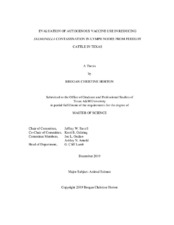| dc.description.abstract | Salmonella prevalence in ground beef has been a continuous challenge in the beef industry. Few studies have presented a potential solution for this problem, as Salmonella prevalence can vary regionally, seasonally, and within the animal. The objective of this study was to evaluate the efficacy of an autogenous Salmonella vaccine in reducing Salmonella prevalence in lymph nodes (LN) of feedlot cattle. Previous research by our team found the most common salmonellae serovars from cattle managed at a South Texas feeding operation, with historically high Salmonella prevalence, to be S. Kentucky, S. Anatum, S. Meunchen, S. Montevideo, and S. Brandenburg. An autogenous vaccine was developed using the serovars above. This is one of the first studies designed to evaluate the efficacy of an autogenous Salmonella vaccine, using serovars specific to a given area. Fifty-five heifers were divided evenly across five vaccination treatment groups: (1) BASE – cattle received no vaccination and were harvested after the stocker stage, (2) CNTRL – cattle received no vaccination, (3) – FARM cattle received vaccination at the ranch only, (4) SPLIT – cattle received vaccination at both the ranch and feedlot, and (5) YARD – cattle received vaccination at the feedlot only. All treatment groups, except BASE, were harvested after the finishing stage in the feedlot. After harvest, left and right superficial cervical and subiliac LNs from each carcass were collected. The USDA-FSIS Microbiological Laboratory Guidebook (MLG) 4.10 was followed to isolate Salmonella in LNs. Polymerase Chain Reaction was used to confirm presumptive positives, and isolates were submitted to National Veterinary Services Laboratory for serotyping. No Salmonella isolates were detected in LN samples from the BASE, FARM, SPLIT, or YARD groups.
Cattle in the BASE group were expected to have low Salmonella prevalence based on previous research. The CNTRL group had a Salmonella prevalence rate of 18.2%. The cause of low Salmonella prevalence rates in nonvaccinated cattle housed with vaccinated cattle is unknown and provides opportunity for future investigation into autogenous vaccine development to combat Salmonella prevalence in feedlots. | en |


